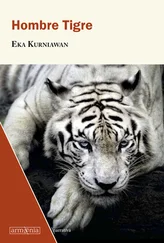So it began. There was excitement and there was fear. Two soldiers started crying for their mothers, but when the commander threatened to send them home their bravery resurfaced and they swore they would win every battle or die trying. The troops moved into their designated positions, carrying the short-muzzled carbine pistols and Steyer rifles they had stolen from the KNIL, and a small cannon and an eight-millimeter mortar stolen from the daidan . Only the shodancho and budancho carried guns, while the enlisted men, who the Japanese called giyukei , carried bayonets or simple sharpened bamboo spears. Two scouts walked slightly ahead of the group while two more guarded the rear. With whatever weapons they had, they intended to win the battle against the most impressive troops in Asia, troops who had beaten Russia and China and chased out the French, the British, and the Dutch from their colonies, troops who were now making war against almost half the world, troops who had taught them how to hold their weapons properly.
“The hero always wins,” said Shodancho in encouragement. “Even though it always takes a while.”
On the first day of the guerrilla war, Shodancho’s group attacked a truck heading for the delta, where Bloedenkamp prison was located. They detonated a mortar right underneath the truck and the gas tank exploded, killing all the Japanese soldiers inside. A courier next reported that the western troops had engaged in open fighting with Japanese soldiers on the outskirts of the jungle, and after a fierce battle Bagong and his men had managed to slip away and it seemed as though the Japanese troops would not pursue them. The northern group attacked the Japanese all along the main road but then were ambushed by a large battalion. They received an order to return to the daidan , and so shodancho Sadrah and all his soldiers returned to the city in surrender.
“Even a donkey remembers to forget the way home,” said Shodancho. “He’s dumber than an ass.”
On the second day they were intercepted by Japanese troops and fought in skirmishes all along the riverbank. They were able to kill two Japanese soldiers, but they paid too high a price — five rebel soldiers perished, and then they were besieged. In an attempt to save themselves, they jumped into the river and became targets for enemy fire. After a rescue operation resulted in the death of another of their men, Shodancho and a number of his soldiers escaped.
He quickly changed his route and plans. They would return, but not to surrender, the greatest tactic his men had ever heard. To the south of the city there was a protected forest, and they walked in a circle through the mangrove swamps before climbing up the cliffs from a shell-strewn beach and entering the jungle. The Japanese and Peta soldiers chasing them were tricked, thinking they would continue east in order to reconnoiter with the rebels from other daidan , as they had originally planned. Shodancho had quickly calculated: the rebellion had failed. Japan had found them out, and the other daidan hadn’t helped, so the best plan was to escape into the forest closest to the city, and from there prepare for a real guerrilla war.
They hid in a cave for a number of days, because the fishermen could see them from their boats out on the ocean. A scout was sent to determine the condition of the western battalion, and of the city in general. He returned with bad news: the Japanese and Peta soldiers had ransacked the forest where the western battalion had been hiding. Bandits and thieves had been allowed to escape, but the rebels had been taken alive. With nothing left but bayonets and bamboo spears, the battalion did not surrender and so the sixty remaining soldiers, including Shodancho Bagong and his chudancho adviser, would be executed on the 24th of February in the yard in front of the daidan .
Shodancho came down off the mountain disguised as a skinny hobo covered in scabies, with his clothes in tatters. The disguise wasn’t too difficult to pull off, because after ten days as a guerrilla he was practically indistinguishable from an actual beggar. With his dirty stiff hair, he entered the city and not a soul recognized him. He walked along the pavement, his hands clutching a tin can with a stone inside, which he rattled softly. In front of the daidan headquarters, he stopped under a flame tree at the side of the road, and witnessed the execution. One by one the sixty men were shot, their corpses thrown into a truck and dumped in front of the gravedigger’s house.
“Don’t ever hope to die just to be remembered,” he said to his remaining soldiers as they raised the flag in mourning back at the guerrilla stronghold. “Believe me, not many people are prepared to remember anything that isn’t their immediate concern.”
He plotted an act of vicious revenge. One night, he led an ambush against a military post and stole some ammunition before killing six Japanese soldiers and throwing their corpses into the street. They blew up a truck and then disappeared before the morning cock crowed. The six Japanese corpses strewn in the street threw the city into an uproar the next day, and the people wondered who had done such a thing. But the Japanese and the daidan , including Sadrah, quickly realized: Shodancho was still alive, and he had declared a never-ending war.
The Japanese from the Kempeitai retaliated in a blind rampage, and soon lost the trace. Soldiers ransacked people’s houses, looking for Shodancho and his men, but got no answers. On the third day after the murder of the six Japanese, a warehouse worth of food and a truck were stolen, and the two Japanese guarding it were killed. The truck was found plunged into the river but all of the food was gone. The Japanese combed the length of the river and found nothing.
Two days later, a courier came one night to Shodancho’s guerrilla hut and told him that news of their insurgence had reached almost everyone on Java. Their uprising had already inspired a number of other small rebellions in a number of daidan , and even though all had failed, the Japanese were gravely concerned and it had even been rumored that Peta was going to be dispersed and all their weapons stripped.
“That’s the risk of keeping a hungry tiger as a pet,” said Shodancho.
Four days later they blew up a bridge just as five Japanese trucks loaded with soldiers were driving over it. That isolated Halimunda for months, and the guerrillas were safe in their hideouts.
On one bright unforgettable morning, Shodancho had just finished taking a shit in a coral reef when he came across a man’s corpse, tossed ashore by the waves. The corpse, already so swollen that it looked like it was about to explode, was wearing nothing but a loincloth. Shodancho and his men pulled the corpse of this drowned man onto the beach and inspected it. There was a deep wound in his stomach.
“That’s the slash of a bayonet,” said Shodancho. “He was killed by the Japanese.”
“He’s a rebel from another daidan ,” said a soldier.
“Or maybe he slept with Kaiser Hirohito’s mistress.”
All of a sudden Shodancho fell silent, looking at the corpse’s face. He was obviously a native — his face was gaunt as if he hadn’t had enough to eat, like most of the natives, and looked slippery without a mustache or beard. But that wasn’t what interested him, it was the odd shape of the man’s mouth. He finally came to the conclusion, “This man is sucking on something.” With significant effort and the help of another soldier, he pried open the corpse’s stiff jaws with his fingers.
“There’s nothing there,” said the soldier.
“No,” replied Shodancho, and he groped around in the corpse’s mouth and removed a scrap of paper that had almost completely disintegrated. “He was killed for this,” said Shodancho. He spread out the paper on top of a warm piece of coral. It looked like a leaflet, printed by a mimeograph machine. The seawater that had leaked into the corpse’s mouth had caused the ink to fade and run, but Shodancho could still make it out. Everyone’s heart was pounding, expecting an important message, because no one would be killed for carrying some meaningless old wadded-up leaflet. With his fingers trembling (and not from the frigid air or from hunger), Shodancho held the piece of paper with tears streaming down his face. Before his confused soldiers had the chance to ask him anything he spoke first, asking them, “What date is it today?”
Читать дальше











